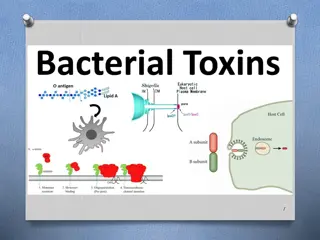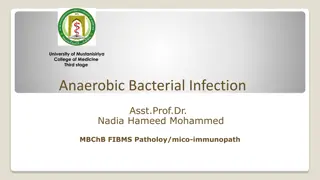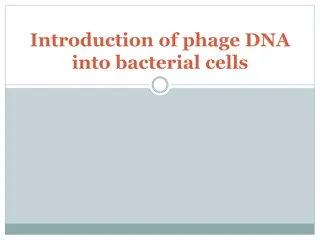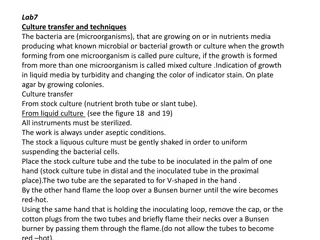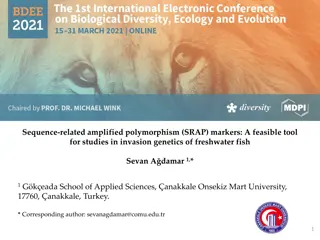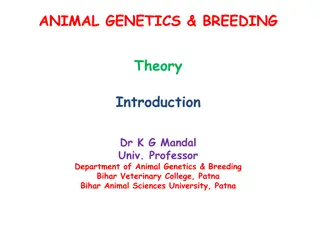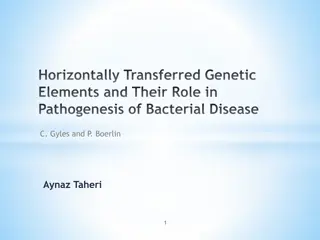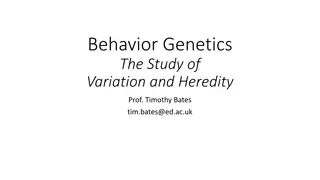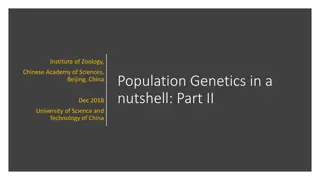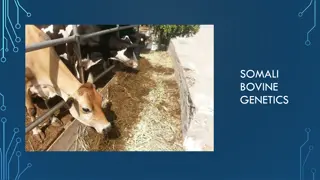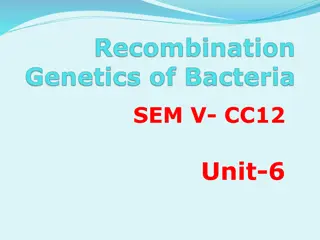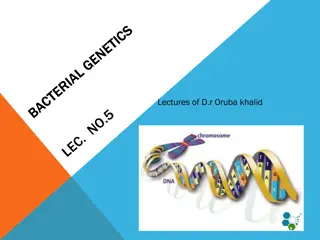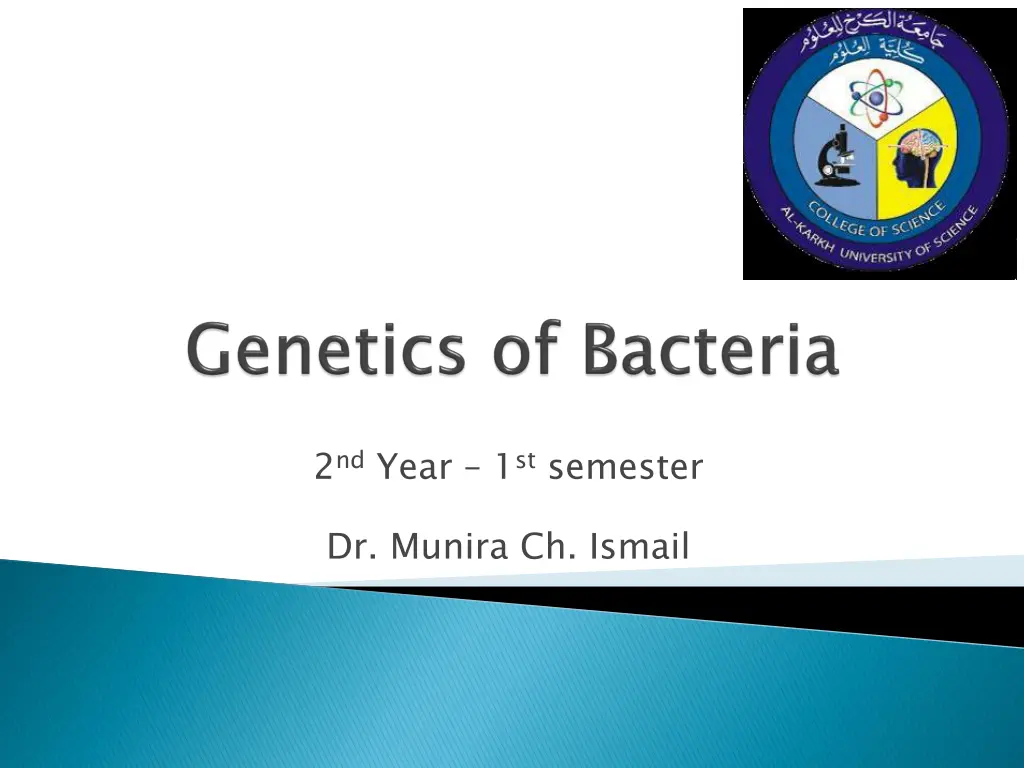
Genetics of Bacteria: Understanding DNA and RNA Structures
Explore the fundamentals of genetics in bacteria, focusing on DNA and RNA structures, nucleotides, and genetic information storage. Learn about chromosomes, pentose sugars, and nucleosides in this comprehensive overview.
Download Presentation

Please find below an Image/Link to download the presentation.
The content on the website is provided AS IS for your information and personal use only. It may not be sold, licensed, or shared on other websites without obtaining consent from the author. If you encounter any issues during the download, it is possible that the publisher has removed the file from their server.
You are allowed to download the files provided on this website for personal or commercial use, subject to the condition that they are used lawfully. All files are the property of their respective owners.
The content on the website is provided AS IS for your information and personal use only. It may not be sold, licensed, or shared on other websites without obtaining consent from the author.
E N D
Presentation Transcript
2ndYear 1stsemester Dr. Munira Ch. Ismail
Genetics of Bacteria: The heredity, or constancy and change in the vast array of physiologic functions that form the properties of organisms. Gene segment of DNA that carries in its nucleotide sequence information for a specific biochemical or physiologic property. DNA material that specifies protein synthesis in cells. RNA Chromosome into thread like structures inside nucleus. Each chromosomes is made up of DNA tightly coiled many times around proteins called histones that support its structure. See the following figure: Genetics of Bacteria: science of genetic defines and analyzes Gene : The unit of heredity which composed of a DNA: Nucleic acid found in cells; the genetic RNA :A polymer of ribonucleotides. Chromosome : The DNA molecule that's packaged
Each chromosome has a constriction point called the centromere, which divides the chromosome into two sections, or arms. The short arm of the chromosome is labeled the p arm. The long arm of the chromosome is labeled the q arm. The location of the centromere chromosome its characteristic shape, and can be used to help describe the location of specific genes. Chromosomes vary in number and shape among living things. Most bacteria have one or two circular chromosomes. Whereas human along with chromosomes that are arranged in the nucleus. on each chromosome gives the other animals and plants, have linear
A pentose phosphate and 4 nitrogenous bases.Pentose sugar are of two types either deoxyribose such as in DNA or ribose in RNA. See the following figure : http://iws.collin.edu/biopage/faculty/mcculloch/1408/notes/macromolecules/images/pentose%20sugar.jpg
Are organic molecules that serve as subunits of N. acid like DNA and RNA. It considered as building block of N. acids. Nucleotides are composed of phosphate bonding to pentose ( five carbon) and to nitrogenous base.
The combination of base with sugar pentose called Nucleoside. Genetic information is stored as a sequence of bases in deoxyribonucleic acid ( DNA)except in a bacteriophages & some viruses such as reovirus and numerous plants and animal is ribonucleic acid (RNA). All types of cells contain 4 units or base linked to various sequences by 3-to 5-phosphodister. There are 4 kinds of nitrogenous bases in DNA. These fall into two classes, purines and pyrimidines. The purine bases are referred to as A and G and the pyrimidines as T and C. In RNA there is a U base instead of the T that's paired by hydrogen bonding in the centre of molecule. Most DNA molecule are double strand with complementary bases such as (A-T; G-C). The complementarily of the bases enables one strand( template strand) to provide the information for copying or expression of information in other strand . See the following fig.
1. The DNA in various spp. Or cells composed of the same bases. 2. The base composition of DNA varies from one individual to another. 3. The base composition of DNA of a given species nutritional changes. 4. The number of adenine residues is equal to the number of thymine. does not change or with age, states, environmental
Template for DNA replication. Template for DNA transcription for protein synthesis. Properties of the genetic material : It has the ability to store and transmit genetic material as needed. It has the ability to transfer genetic information with minimal errors. Physical and chemical stability preventing the information from being lost. Capability for genetic changes without major loss. Properties of the genetic material :
Nucleic acids: The chromosomes of higher organisms are composed of nucleoprotein ( organic acid), found predominantly in the nucleus of the cells. Only the nucleic acids carry the genetic information in all organisms. The DNA is a double helical structure of an extremely thread like macromolecule made up of a large number of nucleotides composed of a nitrogenicbases , sugar, and phosphate group. The sugar in deoxyribonucleotides which is deoxyribose, indicates that this sugar lacks an oxygen which is present in ribose sugar. The nitrogen base is a derivative of either purines or pyrimidines.The purines in DNA are A & G, while the pyrimidines are T & C. The discovery of DNA double helix by Watson & Crick ( 1953 understanding of gene function in molecular terms. DNA double helix by Watson & Crick ( 1953) ) made a revolution in biology, they lead to the
Two double helical polynucleotide chains are coiled around a common axis and they run in an opposite directions. The purines only linked with pyrimidines and vice versa, for this reason adenine only pairs with thymine and guanine only with cytocine. There are thousands of nucleotide pairs even in such simple organisms as viruses. The diameter of the helix is 10 A , adjacent bases are separated by 3.4 A . The two chains of nitrogenous bases are held together by hydrogen bonds. The sequence of bases as a chain carries the genetic information. ACCCCGTGGCATT TGGGGCACCGTAA The E. coli bacteria have a single circular chromosome with 4 million base pairs
RNA( ribonucleic acid) is a polymer of nucleotides which is made up of a ribose sugar, a phosphate, and bases such as adenine, guanine, cytosine, and uracil. RNA has a structure very similar to that of DNA. The key difference in RNA structure is that the ribose sugar in RNA has a hydroxyl (- OH) group which is absent in DNA. RNA plays a very crucial role in the gene expression pathway by which genetic information in DNA is coded into proteins that determine cell function.
RNA single stranded while the DNA is doubled. RNA contains uracil instead of thymine. RNA contains ribose sugar in DNA contains deoxyribose sugar. RNA are generally much shorter than DNA molecules. The role of RNA inside the cell is synthesis of protein while DNA is carrying of genetic information.
Messenger RNA carries codes from the DNA in the nucleus to the sites of protein synthesis in the cytoplasm (the ribosomes). Ribosomalribonucleicacid component of the ribosome, and is essential for protein synthesis in all living organisms. Transferribonucleicacid molecule that helps decode a messenger RNA (mRNA) sequence into a protein.tRNAsfunction specific sites in the ribosome during translation, which is a process that synthesizes a protein from an mRNA molecule. Messenger RNA (mRNA mRNA), molecule in cells that Ribosomalribonucleicacid (rRNA rRNA): ): is the RNA Transferribonucleicacid( (tRNA tRNA): ):is a type of RNA function at
A plasmid is a small, circular, double-stranded DNA molecule that is distinct from a cell's chromosomal DNA. Plasmids naturally exist in bacterial cells, and they also occur in some eukaryotes. Often, the genes carried in plasmids provide bacteria with genetic advantages, such as antibiotic resistance. Plasmids have a wide range of lengths, from roughly one thousand DNA base pairs to hundreds of thousands of base pairs. When a bacterium divides, all of the plasmids contained within the cell are copied such that each daughter cell receives a copy of each plasmid. Bacteria can also transfer plasmids to one another through a process called conjugation. The replication of plasmid may play a role in virulent of bacteria and in resistant of antibiotics. It is present either as single or more in one cell
is a sequence of DNA that can move to new positions within the genome of a single cell. The press called them jumping is not correct to call them 'genes'. Transposons McClintock her jumping genes genes, but it Transposons were McClintock while her work were first while received in 1983 first found received a a Nobel found by Nobel Prize by Barbara Prize for Barbara for work in 1983. .

